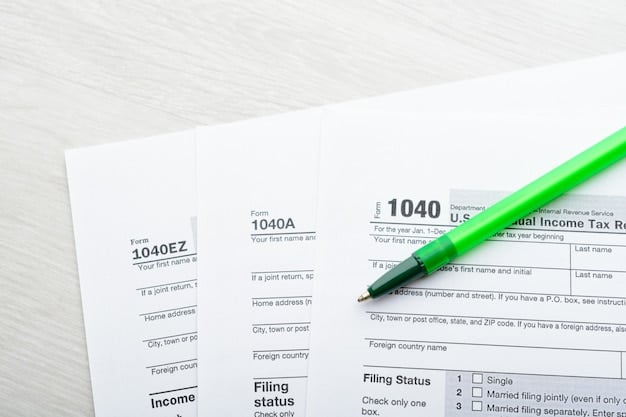Maximize Your Savings: A Guide to the Updated Saver’s Credit for 2025

Maximize Your Savings: Understanding the Updated Saver’s Credit for 2025 dives into eligibility, contribution limits, and how this tax credit can significantly boost retirement savings for low-to-moderate-income individuals and families, offering a valuable financial incentive.
Planning for retirement can be daunting, especially when navigating the complexities of financial planning. However, there are valuable resources available to help ease the burden. One such tool is the Maximize Your Savings: Understanding the Updated Saver’s Credit for 2025, a tax credit designed to encourage low-to-moderate-income taxpayers to save for retirement.
What is the Saver’s Credit?
The Saver’s Credit, officially known as the Retirement Savings Contributions Credit, is a tax break offered by the U.S. government. It’s specifically designed to help individuals and families with modest incomes save for their future retirement. Unlike a tax deduction, which reduces your taxable income, a tax credit directly reduces the amount of tax you owe, making it a more valuable benefit for those who qualify.
Essentially, the Saver’s Credit incentivizes retirement savings by offering a financial reward for contributing to eligible retirement accounts. This can include traditional and Roth IRAs, 401(k) plans, 403(b) plans, and other qualified retirement plans. By understanding the Saver’s Credit, eligible individuals can take a significant step toward securing their financial future.

Who is Eligible for the Saver’s Credit?
Eligibility for the Saver’s Credit is primarily based on your adjusted gross income (AGI). The income limits are adjusted annually to account for inflation, so it’s important to check the current limits for the tax year you’re claiming the credit. Generally, to qualify, you must be:
- At least 18 years old.
- Not a student.
- Not claimed as a dependent on someone else’s return.
In addition to these basic requirements, your adjusted gross income (AGI) must fall within certain limits. For 2025 (taxes filed in 2026), the AGI thresholds are expected to be updated based on inflation. Keeping an eye on these updated limits is crucial to determine your eligibility.
Understanding the specific AGI thresholds for your filing status is essential to determine whether you qualify for the Saver’s Credit. Be sure to consult the IRS guidelines or a tax professional for the most accurate and up-to-date information.
Understanding the Contribution Limits
The amount of the Saver’s Credit you can claim depends on your AGI and your contribution amount. The maximum contribution that qualifies for the credit is $2,000 if you’re filing as single, head of household, or married filing separately, and $4,000 if you’re married filing jointly. However, the actual credit you receive is a percentage of your contribution, based on your AGI bracket.
The Saver’s Credit offers different credit rates based on income. The credit rate can be 50%, 20%, or 10% of your contribution, depending on your AGI. The lower your income, the higher the potential credit rate. It’s important to understand these rates to maximize your savings effectively.
How the Credit Rate Works
- 50% Credit Rate: This is the most generous rate, available to those with the lowest AGI. If you qualify for this rate and contribute the maximum amount, you could receive a credit of $1,000 (single) or $2,000 (married filing jointly).
- 20% Credit Rate: This rate is for taxpayers with slightly higher incomes than those in the 50% bracket. While the credit is lower, it still provides a significant incentive to save.
- 10% Credit Rate: This is the lowest rate, available to those with the highest AGI who still qualify for the credit. Even at this rate, it’s a valuable benefit that can help boost your retirement savings.
Understanding these income brackets and their corresponding credit rates is essential for maximizing the benefits of the Saver’s Credit. Consult the latest guidelines from the IRS or a tax professional to determine the exact rates and income thresholds for the 2025 tax year.
Which Retirement Accounts Qualify?
To be eligible for the Saver’s Credit, your contributions must be made to a qualifying retirement account. These accounts include:
- Traditional IRA
- Roth IRA
- 401(k) plan
- 403(b) plan
- Other qualified retirement plans
Contributions to these plans can help you not only save for retirement but also potentially reduce your tax burden through the Saver’s Credit. Understanding the nuances of each account type can help you make informed decisions about where to invest your money.
Traditional IRA vs. Roth IRA
While both Traditional and Roth IRAs qualify for the Saver’s Credit, they offer different tax advantages. Traditional IRAs offer tax-deductible contributions, meaning you can deduct your contributions from your taxable income in the year you make them. However, your withdrawals in retirement will be taxed as ordinary income. Roth IRAs, on the other hand, do not offer an upfront tax deduction, but your qualified withdrawals in retirement are tax-free.
Choosing between a Traditional IRA and a Roth IRA depends on your individual circumstances and expectations about future tax rates. If you anticipate being in a higher tax bracket in retirement, a Roth IRA may be more beneficial. If you need the upfront tax deduction now, a Traditional IRA may be a better choice.
Regardless of which type of IRA you choose, contributing to either can help you qualify for the Saver’s Credit, providing an additional incentive to save for retirement.
How to Claim the Saver’s Credit
Claiming the Saver’s Credit involves completing IRS Form 8880, Credit for Qualified Retirement Savings Contributions. This form requires you to provide information about your qualifying retirement contributions and your adjusted gross income (AGI). The form is relatively straightforward, but it’s essential to follow the instructions carefully to ensure you claim the correct amount of credit.
First, you’ll need to determine your eligibility based on the AGI limits and other requirements. Then, you’ll need to calculate the amount of your qualifying retirement contributions. Finally, you’ll use Form 8880 to calculate the amount of the credit you’re eligible to claim.

Tips for Completing Form 8880
- Gather all necessary documentation, including your W-2 form, 1099 forms, and any documentation related to your retirement contributions.
- Carefully review the instructions for Form 8880 to ensure you understand the requirements and calculations.
- Double-check your calculations to avoid errors that could delay your refund or result in an audit.
- If you’re unsure about any aspect of claiming the Saver’s Credit, consult a tax professional for assistance.
By following these tips and taking the time to understand the requirements, you can successfully claim the Saver’s Credit and reduce your tax liability while saving for retirement.
Planning for 2025 and Beyond
As you consider planning your retirement savings for 2025 and beyond, it’s essential to stay informed about any updates or changes to the Saver’s Credit. The income limits and other eligibility requirements are subject to change, so it’s important to check the latest guidelines from the IRS or a tax professional.
In addition to staying informed about the Saver’s Credit, it’s also important to review your overall retirement savings strategy. Consider factors such as your age, income, risk tolerance, and retirement goals. A well-thought-out strategy can help you maximize your savings and ensure a comfortable retirement.
The Saver’s Credit is a valuable tool for low-to-moderate-income individuals and families looking to save for retirement. By understanding the eligibility requirements, contribution limits, and how to claim the credit, you can take advantage of this benefit and secure your financial future.
| Key Point | Brief Description |
|---|---|
| 💰 Saver’s Credit Intro | Tax credit to encourage retirement savings for low/moderate income individuals. |
| ✅ Eligibility | Must be 18+, not a student, not a dependent, and meet AGI limits. |
| 📈 Contribution Limits | Max contribution of $2,000 (single) or $4,000 (married filing jointly) qualifies. |
| 🏦 Qualifying Accounts | Traditional IRA, Roth IRA, 401(k), 403(b), and other qualified plans. |
Frequently Asked Questions
▼
The Saver’s Credit is a tax credit designed to help low-to-moderate income individuals save for retirement. It reduces your tax liability based on contributions to qualifying retirement accounts, like IRAs and 401(k)s.
▼
To be eligible, you must be at least 18 years old, not a student, not claimed as a dependent on someone else’s return, and meet specific adjusted gross income (AGI) limits, which vary by filing status.
▼
Qualifying accounts include traditional IRAs, Roth IRAs, 401(k) plans, 403(b) plans, and other qualified retirement plans where contributions are made.
▼
To claim the Saver’s Credit, you must complete IRS Form 8880, Credit for Qualified Retirement Savings Contributions, and submit it along with your tax return, reporting contributions and AGI.
▼
Unfortunately, if your income exceeds the AGI limit for your filing status in a given tax year, you will not be eligible for the Saver’s Credit. Check the IRS guidelines for current limits.
Conclusion
The Maximize Your Savings: Understanding the Updated Saver’s Credit for 2025 can be a game-changer for individuals looking to bolster their retirement savings. Armed with the right knowledge about eligibility, contribution limits, and qualifying accounts, you can take advantage of this credit and move closer to a financially secure retirement.





